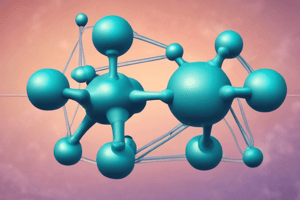Podcast
Questions and Answers
What type of bond is a covalent bond between two atoms in which the shared electron pair comes from only one of the atoms?
What type of bond is a covalent bond between two atoms in which the shared electron pair comes from only one of the atoms?
- Coordinate covalent bond (correct)
- Double covalent bond
- Nonpolar covalent bond
- Hydrogen bond
What occurs when a hydrogen atom that is covalently bonded to a very electronegative atom is also weakly bonded to an unshared pair of electrons?
What occurs when a hydrogen atom that is covalently bonded to a very electronegative atom is also weakly bonded to an unshared pair of electrons?
Hydrogen bond
Which of the following is a covalent bond involving two pairs of electrons where each atom donates one pair?
Which of the following is a covalent bond involving two pairs of electrons where each atom donates one pair?
- Coordinate covalent bond
- Triple covalent bond
- Single covalent bond
- Double covalent bond (correct)
What type of covalent bond is formed by the equal sharing of bonding electrons by two atoms?
What type of covalent bond is formed by the equal sharing of bonding electrons by two atoms?
What is a force that occurs when a hydrogen atom is weakly bonded to an unshared pair of electrons?
What is a force that occurs when a hydrogen atom is weakly bonded to an unshared pair of electrons?
What is the term for a covalent bond that involves three pairs of electrons shared by two atoms?
What is the term for a covalent bond that involves three pairs of electrons shared by two atoms?
What describes a substance in which all atoms are covalently bonded to each other?
What describes a substance in which all atoms are covalently bonded to each other?
Which of these elements does not exist as a diatomic molecule?
Which of these elements does not exist as a diatomic molecule?
Which one of the following compounds is not covalent?
Which one of the following compounds is not covalent?
How many valence electrons does an atom of any halogen have?
How many valence electrons does an atom of any halogen have?
What is the electron dot structure for water?
What is the electron dot structure for water?
Which of the following compounds is not ionic?
Which of the following compounds is not ionic?
What occurs when atoms share electrons?
What occurs when atoms share electrons?
What is the electron dot structure for the polyatomic ion OH-?
What is the electron dot structure for the polyatomic ion OH-?
Which of these compounds would not have covalent bonds?
Which of these compounds would not have covalent bonds?
What is a molecule with a single covalent bond?
What is a molecule with a single covalent bond?
What explains why chlorine is a gas, bromine is a liquid, and iodine is a solid?
What explains why chlorine is a gas, bromine is a liquid, and iodine is a solid?
Which of the following molecules has one lone pair of electrons?
Which of the following molecules has one lone pair of electrons?
Which of the following is the weakest?
Which of the following is the weakest?
What is the shape of the carbon tetrachloride molecule?
What is the shape of the carbon tetrachloride molecule?
Flashcards
Coordinate Covalent Bond
Coordinate Covalent Bond
A bond where both electrons are provided by one atom.
Nonpolar Covalent Bond
Nonpolar Covalent Bond
Equal electron sharing results in no (or negligible) charge separation.
Polar Bond
Polar Bond
Unequal electron sharing leads to partial charges on atoms.
Hydrogen Bond
Hydrogen Bond
Signup and view all the flashcards
Double Covalent Bond
Double Covalent Bond
Signup and view all the flashcards
Triple Covalent Bond
Triple Covalent Bond
Signup and view all the flashcards
Single Covalent Bond
Single Covalent Bond
Signup and view all the flashcards
Molecular Formula
Molecular Formula
Signup and view all the flashcards
Structural Formula
Structural Formula
Signup and view all the flashcards
Dispersion Force
Dispersion Force
Signup and view all the flashcards
Dipole Interactions
Dipole Interactions
Signup and view all the flashcards
Halogens
Halogens
Signup and view all the flashcards
Polyatomic Ions
Polyatomic Ions
Signup and view all the flashcards
Covalent Compounds
Covalent Compounds
Signup and view all the flashcards
Network Solids
Network Solids
Signup and view all the flashcards
Molecule Shape
Molecule Shape
Signup and view all the flashcards
Lone Pairs of Electrons
Lone Pairs of Electrons
Signup and view all the flashcards
Electron Dot Structures
Electron Dot Structures
Signup and view all the flashcards
Compounds Without Covalent Bonds
Compounds Without Covalent Bonds
Signup and view all the flashcards
Covalent Bond
Covalent Bond
Signup and view all the flashcards
Study Notes
Covalent Bonding Concepts
- Coordinate Covalent Bond: Formed when two atoms share a pair of electrons, where both electrons come from only one atom.
- Nonpolar Covalent Bond: Occurs when two atoms share bonding electrons equally, leading to no charge separation.
- Polar Bond: Happens between atoms of different electronegativities, resulting in unequal sharing of electrons and partial charges.
Types of Bonds
- Hydrogen Bond: A weak bond that occurs when hydrogen, covalently bonded to an electronegative atom, is attracted to another electronegative atom's unshared electron pair.
- Double Covalent Bond: Involves two pairs of electrons shared between two atoms, with each atom contributing one pair.
- Triple Covalent Bond: Involves the sharing of three pairs of electrons between two atoms.
- Single Covalent Bond: Involves the sharing of one pair of electrons, as seen in molecules like F2.
Molecular and Structural Formulas
- Molecular Formula: Represents the types and quantities of atoms in a molecule of a compound (e.g., CO2 for carbon dioxide).
- Structural Formula: Illustrates the arrangement of atoms and the connections between them in molecules and polyatomic ions.
Molecular Interactions
- Dispersion Force: Caused by the motion of electrons, it represents the weakest type of intermolecular forces.
- Dipole Interactions: Arise from polar molecules and vary in strength; variations lead to differing states of matter (e.g., Cl gas, Br liquid, I solid).
Valence Electrons and Bonds
- Halogens: Each has seven valence electrons, crucial for bonding behavior.
- Polyatomic Ions: Example is the hydroxide ion (OH−) with a specific electron dot structure.
Compound Classification
- Covalent Compounds: Examples include CO2 and N2, which feature covalent bonding, while ionic compounds like KCl do not share electrons; they involve electrostatic attraction between charged ions.
- Network Solids: Substances in which all atoms are covalently bonded to one another; possess high melting points and unique properties.
Molecular Geometry
- Molecule Shape: Carbon tetrachloride (CCl4) has a tetrahedral structure, impacting its physical and chemical properties.
- Lone Pairs of Electrons: Molecules like NH3 (ammonia) have a lone pair influencing their geometry and reactivity.
Additional Points
- Weakest Interactions: Among dipole interactions, dispersion forces are considered the weakest.
- Electron Dot Structures: Visualization of bonding, such as the structure of water (H₂O) displays shared electrons graphically.
- Compounds Without Covalent Bonds: Examples like K2O highlight compounds solely composed of ionic bonds.
Studying That Suits You
Use AI to generate personalized quizzes and flashcards to suit your learning preferences.




